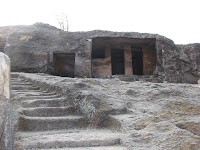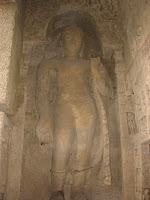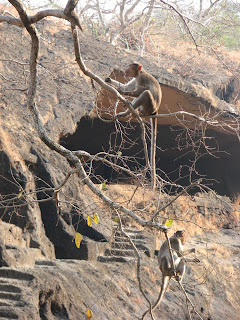Kanheri caves - Buddhist Viharas and Architectural Marvel
Kanheri caves - Buddhist Viharas and Architectural Marvel
In Mumbai suburb called Borivali lies the magnificent and lush green Sanjay Gandhi National Park. Its a breathing space for all Mumbaikars away from concrete jungle and pollution in the air. Its a ideal place for anyone who would like to go for birding between August to March or for those who just wants to go for a walk or a small picnic in the middle of forest. Its in full glory during monsoon season when the forest turns lush green. The National park is the single largest concentration of flora and fauna in metropolitan city of Mumbai.Amidst this magnificent patch of forest land in the heart of Mumbai lies the heritage site of Kanheri caves also called Krishnagiri caves.

National park becomes home to migratory birds from August to March.




The caves of Kanheri dates back to 11 century AD and beyond. The construction of the caves started in 1st century BC and went right upto 11century AD. Most of the caves are Buddhist Viharas meant for living, study and meditation of Buddhist monks.The history also proves that Kanheri was a University center for Buddhist during the rule of Mauryan and Kushan empires. The caves are so articulately carved with idols of Lord Buddha, stupas, place of worship and meditation, caves carved with stone bed and rain water storing facility outside each cave. The complex has total of 105 caves with meticulously carved steps on the basalt rock mountain to reach at the top.
The entrance to the caves complex has the above stone sculpture giving the insight about the history of the caves.

Above cave dates back to 5th and 6th century AD. The double storied carved from the rocks clearly makes us wonder how the artisans of that era would have planned and executed the work.
The above cave also reminds us of world famous heritage site of "Petra in Jordan". Could this be the smaller version of India's answer to Petra ??????
During my trip as we climbed to the top of the mountain, I was able to capture some of the caves on the way in my lens. Noticeable thing about these caves was the caves at the top were smaller ones with door, air circulating vent, and rock cut bed which typically meant it was for staying purpose but the caves which were at the entrance of the caves complex were bigger and more prominent were chaityagrhas meant for meditation and teaching as they had huge pillars and stupas, congressional halls.





The highest cave in the complex is situated at the height of 1500 ft from sea level.
Some the caves had carvings of Lord buddha in different mudra and also the caves which were used for meditation, teachings had pillars and stupas as can be seen in the pics. Some the carvings on the walls of the caves captured in the lens below.






The road leading to the caves complex passes through the National park and gives Mumbaikars a quick gateway away from hustle and bustle of daily life amidst amazing natural surroundings.
The best time to visit is during winter months from October to March or during monsoon season from June to August when the hilly terrain of the caves creates small and large waterfalls. The caves are located at approx 6kms from the National park gates and buses are available every one hour. Tourist are allowed in the National park from 07.30 am to 05.00pm




Some Monkey stunts at National park. Njoy
In Mumbai suburb called Borivali lies the magnificent and lush green Sanjay Gandhi National Park. Its a breathing space for all Mumbaikars away from concrete jungle and pollution in the air. Its a ideal place for anyone who would like to go for birding between August to March or for those who just wants to go for a walk or a small picnic in the middle of forest. Its in full glory during monsoon season when the forest turns lush green. The National park is the single largest concentration of flora and fauna in metropolitan city of Mumbai.Amidst this magnificent patch of forest land in the heart of Mumbai lies the heritage site of Kanheri caves also called Krishnagiri caves.

National park becomes home to migratory birds from August to March.
 |
| My best shot |
 |
| My best shot |



 |
| Wintery mist in the air |
 |
| Road towards Kanheri caves |

The caves of Kanheri dates back to 11 century AD and beyond. The construction of the caves started in 1st century BC and went right upto 11century AD. Most of the caves are Buddhist Viharas meant for living, study and meditation of Buddhist monks.The history also proves that Kanheri was a University center for Buddhist during the rule of Mauryan and Kushan empires. The caves are so articulately carved with idols of Lord Buddha, stupas, place of worship and meditation, caves carved with stone bed and rain water storing facility outside each cave. The complex has total of 105 caves with meticulously carved steps on the basalt rock mountain to reach at the top.
 |
| History of the caves |
The entrance to the caves complex has the above stone sculpture giving the insight about the history of the caves.

Above cave dates back to 5th and 6th century AD. The double storied carved from the rocks clearly makes us wonder how the artisans of that era would have planned and executed the work.
The above cave also reminds us of world famous heritage site of "Petra in Jordan". Could this be the smaller version of India's answer to Petra ??????
During my trip as we climbed to the top of the mountain, I was able to capture some of the caves on the way in my lens. Noticeable thing about these caves was the caves at the top were smaller ones with door, air circulating vent, and rock cut bed which typically meant it was for staying purpose but the caves which were at the entrance of the caves complex were bigger and more prominent were chaityagrhas meant for meditation and teaching as they had huge pillars and stupas, congressional halls.





The highest cave in the complex is situated at the height of 1500 ft from sea level.
Some the caves had carvings of Lord buddha in different mudra and also the caves which were used for meditation, teachings had pillars and stupas as can be seen in the pics. Some the carvings on the walls of the caves captured in the lens below.






The road leading to the caves complex passes through the National park and gives Mumbaikars a quick gateway away from hustle and bustle of daily life amidst amazing natural surroundings.
The best time to visit is during winter months from October to March or during monsoon season from June to August when the hilly terrain of the caves creates small and large waterfalls. The caves are located at approx 6kms from the National park gates and buses are available every one hour. Tourist are allowed in the National park from 07.30 am to 05.00pm
 |
| Tribal ladies selling star fruit, cucumber and guava |



 |
| Tribal huts inside national park |

Some Monkey stunts at National park. Njoy



















































Comments
Post a Comment